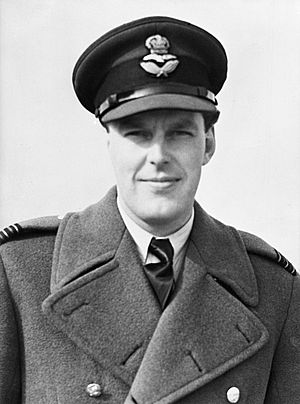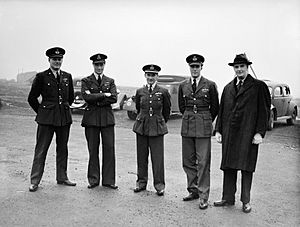Michael Robinson (RAF officer) facts for kids
Quick facts for kids
Michael Robinson
|
|
|---|---|

Robinson, 1942
|
|
| Born | 8 May 1917 Chelsea, London, United Kingdom |
| Died | 10 April 1942 (aged 24) off the French coast |
| Allegiance | United Kingdom |
| Service/ |
Royal Air Force |
| Years of service | 1935–1942 † |
| Rank | Wing Commander |
| Commands held | Tangmere Wing Biggin Hill Wing No. 609 Squadron |
| Battles/wars | Second World War |
| Awards | Distinguished Service Order Distinguished Flying Cross Mention in Despatches |
| Relations | Roy Robinson, 1st Baron Robinson (father) Paul Richey (brother-in-law) |
Michael Lister Robinson (8 May 1917 – 10 April 1942) was a brave Royal Air Force (RAF) pilot during the Second World War. He was known as a "flying ace" because he shot down at least sixteen enemy aircraft.
Born in Chelsea, London, Michael joined the RAF in 1935. After his training, he became an instructor. In 1940, he flew with No. 87 Squadron in France. He was injured in an accident and sent back to the United Kingdom. Once he recovered, he joined No. 601 Squadron. He flew many missions during the Battle of Britain, where he shot down several planes.
For his success, he received the Distinguished Flying Cross. The next year, he became the leader of No. 609 Squadron. He continued to achieve victories, earning the Distinguished Service Order. By August 1941, he was a wing commander and led the Biggin Hill fighter wing. He was sadly killed in action in April 1942.
Contents
Early Life and Joining the RAF
Michael Lister Robinson was born on May 8, 1917, in Chelsea, London, England. His father was Roy Robinson, who would later become a Lord. Michael went to school at Downside School in Bath. A friend from school, Paul Richey, also became a famous pilot and later Michael's brother-in-law.
After finishing school, Michael joined the Royal Air Force in September 1935. He completed his pilot training in August 1936. Then, he joined No. 111 Squadron at Northolt. This squadron was the first to receive the new Hawker Hurricane fighter planes. Michael stayed with this unit until early 1939. He then became an instructor, teaching other pilots to fly.
Flying in the Second World War
In March 1940, after the Second World War had begun, Michael was sent to France. He joined No. 87 Squadron, which flew Hurricane planes from Lille. He became a flight lieutenant on April 16. Michael was involved in an aircraft accident on May 6, which injured his hand. He had to return to the United Kingdom for hospital treatment. By August, he had recovered and was ready to fly again. He was then posted to No. 601 Squadron.
The Battle of Britain
When Michael joined No. 601 Squadron, they were flying Hurricanes from Debden. They saw a lot of activity from the German air force, the Luftwaffe. On August 31, Michael achieved his first victories. He shot down a Messerschmitt Bf 109 fighter near Maidstone. On the same day, over the Thames Estuary, he probably destroyed another Bf 109 and damaged a second.
On September 4, he helped destroy a Messerschmitt Bf 110 heavy fighter near Worthing. Two days later, he shot down another Bf 109 near Mayfield. He probably shot down a Bf 110 on September 25. Soon after, he moved to No. 238 Squadron. On September 30, he shot down two Bf 110s and probably destroyed a Bf 109 during a German raid near Portland.
In early October, Michael became the leader of No. 609 Squadron. His new unit flew Supermarine Spitfire fighters from Middle Wallop. On October 7, he destroyed two more Bf 110s. For his amazing successes, Michael was awarded the Distinguished Flying Cross. The award was announced on November 26, 1940. It said he showed "conspicuous gallantry and leadership" and had destroyed at least six enemy aircraft.
The Circus Offensive
No. 609 Squadron moved to Biggin Hill in February 1941. They started taking part in the "circus offensive." This meant flying over France to try and make German fighters come out and fight. They also escorted British bombers. On May 7, Michael damaged a Bf 109 over the Strait of Dover. The next day, he destroyed two Bf 109s near Dungeness.
He was promoted to temporary squadron leader on June 1. On July 3, during a bombing raid on railway facilities in Hazebrouck, Michael shot down a Bf 109. Later that same day, he shot down another Bf 109 and damaged a third. He continued to damage and destroy more Bf 109s over the next few days and weeks, including near Hardelot, Saint-Omer, Cap Gris-Nez, and Le Touquet.
By the end of July, Michael was promoted to wing commander. He was given command of the fighter wing at Biggin Hill. He was one of the youngest wing leaders in the RAF. A few days later, he received the Distinguished Service Order (DSO) for his leadership of No. 609 Squadron. The award stated that he had "destroyed at least fourteen enemy aircraft and damaged others."
His first victory as leader of the Biggin Hill wing was on August 7, when he probably destroyed a Bf 109. On August 19, he had to crash-land his plane after running out of fuel during a rescue mission. Soon after, he received the Belgian Croix de Guerre for his services in the war. He shot down another Bf 109 on August 27. This was his last victory before he took a break from flying operations.
After his leave, Michael was appointed commander of the fighter wing at Tangmere on January 1, 1942. On April 10, 1942, while flying over occupied France, he was attacked by German Focke Wulf 190 fighters. Both Michael and his wingman were shot down off the French coast and sadly killed.
Michael Robinson has no known grave. He is remembered at the Air Forces Memorial near Egham in Surrey, England. By the time of his death, he was credited with shooting down sixteen German aircraft. He also probably destroyed four more and shared in the destruction of another. He damaged eight other aircraft. His medals are kept at the Imperial War Museum.


